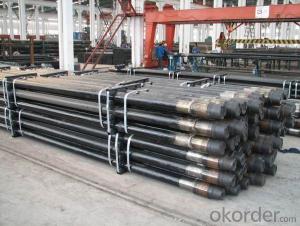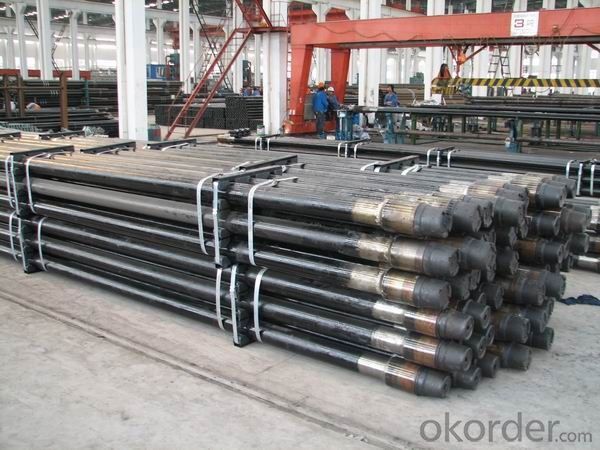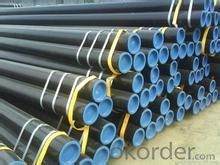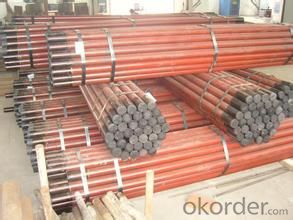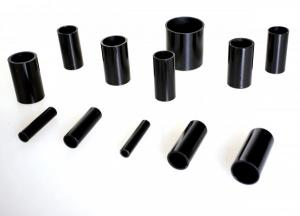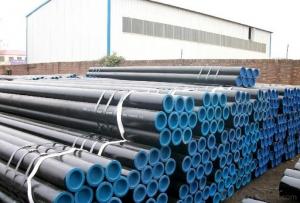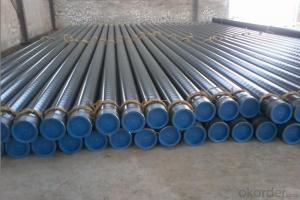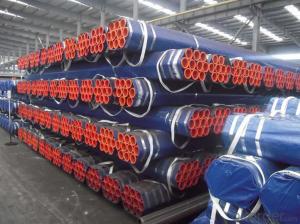Seamless Carbon Drill Rod
- Loading Port:
- China Main Port
- Payment Terms:
- TT or LC
- Min Order Qty:
- 100 m.t.
- Supply Capability:
- -
OKorder Service Pledge
OKorder Financial Service
You Might Also Like
1. Process of High Quality Drill Rod
Process of drill rod generally includes three parts: the pipe end thickening processing tool joints, friction welding, and subsequent processing.
1). The performance and advantages: rod tube ends inside and outside thicker type, the joint use of phosphate or plated steel threaded processing.
2). The product uses: down hole drilling operations, to extend the drill footage;
3). Service: home delivery, tracking services;
4). Packing: steel strapping, compartment plate press-fit.
2. Description of High Quality Drill Rod
We can supply all kinds of drill pipes that are consistent with API SPEC 5DP or SY.
Drill Pipe Price can be made as customers' requirements and be equipped with the same type of tool joints.
Advanced drill pipe production lines can transfer the welding parameters to the best position to ensure the quality of welding zone; the heat treatment process with the feature of internal and external cooling at the same time can make a more reliable and stable mechanical character. Application of automatic weight, length measurement and automatic spray records can ensure products' traceability. Application of thickening and heating lines and 1250 tons of upsetting machine can ensure the thickening size meet the standard of API SPEC 5DR Using of CN furnace for whole pipe body heating and quenching, tempering machine's advanced heat treatment process can ensure the pipe's mechanical character. Tube hydraulic straightening machine ensures the straightness and coaxiality of pipe body.
3. Specification High Quality Drill Rod
| Size | Normal Weight | Calculated Plain-End weight | Grade | Outside Diam. | Wall Thickness | Upset type | Tool Joint | ||||
| in | mm | Lb/ft | Lb/ft | kg/m | Inch | mm | Inch | mm | |||
| 2-3/8 | 60.3 | 6.65 | 6.26 | 9.32 | E,X,G,S | 2.375 | 60.3 | 0.28 | 7.11 | EU | NC26 |
| 2 7/8 | 73 | 10.4 | 9.72 | 14.48 | E,X,G,S | 2.875 | 73 | 0.362 | 9.19 | EU IU | NC31 |
| 3 1/2 | 88.9 | 9.5 | 8.81 | 13.12 | E | 3.5 | 88.9 | 0.254 | 6.45 | EU IU | NC38 |
| 3 1/2 | 88.9 | 13.3 | 12.31 | 18.34 | E,X,G,S | 3.5 | 88.9 | 0.368 | 9.35 | EU IU | NC38,NC40 |
| 3 1/2 | 88.9 | 15.5 | 14.63 | 21.79 | E | 3.5 | 88.9 | 0.449 | 11.4 | EU IU | NC38,NC40 |
| 3 1/2 | 88.9 | 15.5 | 14.63 | 21.79 | X,G,S | 0.449 | 11.4 | EU IEU | |||
| 4 | 101.6 | 14 | 12.93 | 19.26 | E,X,G,S | 4 | 101.6 | 0.33 | 8.38 | EU IU | NC40,NC46 |
| 4-1/2 | 114.3 | 13.75 | 12.24 | 18.23 | E | 4.5 | 114.3 | 0.271 | 6.88 | EU IU | NC46,NC50 |
| 4-1/2 | 114.3 | 16.6 | 14.98 | 22.31 | E,X,G,S | 4.5 | 114.3 | 0.337 | 8.56 | EU IEU | NC46,NC50 |
| 4-1/2 | 114.3 | 20 | 18.69 | 27.84 | E,X,G,S | 4.5 | 114.3 | 0.43 | 10.92 | EU IEU | NC46,NC50 |
| 5 | 127 | 16.25 | 14.87 | 22.15 | X,G,S | 5 | 127 | 0.296 | 7.52 | IU | NC50.5,1/2FH |
| 5 | 127 | 19.5 | 17.93 | 26.71 | E | 5 | 127 | 0.362 | 9.19 | IEU | NC50.5,1/2FH |
| 5 | 127 | 19.5 | 17.93 | 26.71 | X,G,S | 5 | 127 | 0.362 | 9.19 | EU IEU | NC50.5,1/2FH |
| 5 | 127 | 25.6 | 24.03 | 35.79 | E | 5 | 127 | 0.5 | 12.7 | IEU | NC50.5,1/2FH |
| 5 | 127 | 25.6 | 24.03 | 35.79 | X,G,S | 5 | 127 | 0.5 | 12.7 | EU IEU | NC50.5,1/2FH |
4.Strength High Quality Drill Rod
| Grade | Yield Strength | Tensile strength | |||||
| min | max | min | |||||
| Psi | Mpa | Psi | Mpa | Psi | Mpa | ||
| 1 | E-75 | 75 | 517 | 105 | 724 | 100000 | 689 |
| 2 | X-95 | 95 | 655 | 125 | 862 | 105000 | 724 |
| G-105 | 105 | 724 | 135 | 931 | 115000 | 793 | |
| S-135 | 135 | 931 | 165 | 1138 | 145000 | 1000 | |
5.FAQ of High Quality Drill Rod:
①How is the quality of your products?
Our products are manufactured strictly according to national and internaional standard, and we take a test on every pipe before delivered out. If you want see our quality certifications and all kinds of testing report, please just ask us for it.
Guaranteed: If products’ quality don’t accord to discription as we give or the promise before you place order, we promise 100% refund.
②How about price?
Yes, we are factory and be able to give you lowest price below market one, and we have a policy that “ for saving time and absolutely honest business attitude, we quote as lowest as possible for any customer, and discount can be given according to quantity”,if you like bargain and factory price is not low enough as you think, just don’t waste your time.Please trust the quotation we would give you, it is professional one.
③Why should you chose us?
Chose happens because of quality, then price, We can give you both.Additionally, we can also offer professional products inquiry, products knowledge train(for agents), smooth goods delivery, exellent customer solution proposals.Our service formula: good quality+good price+good service=customer’s trust
SGS test is available, customer inspection before shipping is welcome, third party inspection is no problem.
6、High Quality Drill Rod Images:
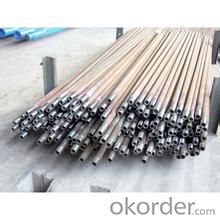
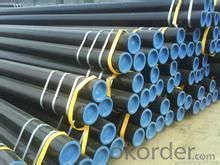
- Q: How are steel pipes protected against soil movement?
- Steel pipes are protected against soil movement through various methods such as using casing pipes, employing anchor systems, implementing protective coatings, and utilizing concrete thrust blocks. These measures ensure that the steel pipes remain stable and secure in the event of soil movement.
- Q: What is the difference between internal coating and external lining of steel pipes?
- The main difference between internal coating and external lining of steel pipes lies in their purpose and location. Internal coating refers to the application of protective materials on the inner surface of the steel pipe, primarily to prevent corrosion, improve flow efficiency, and maintain the quality of transported fluids. On the other hand, external lining involves applying protective materials to the outer surface of the steel pipe, mainly for corrosion resistance, insulation, and protection against external elements. Therefore, while internal coating focuses on the interior protection and performance of the pipe, external lining shields the pipe from environmental factors and external damage.
- Q: What are the different methods of inspecting steel pipes?
- There are several methods of inspecting steel pipes, including visual inspection, ultrasonic testing, magnetic particle testing, dye penetrant testing, radiographic testing, and eddy current testing.
- Q: D108*4 what does "D108" mean by seamless steel tubes? What does "*4" mean?
- Seamless steel pipe: a pipe with a hollow cross section, used as a conduit for transporting fluids, such as pipelines for transporting petroleum, natural gas, gas, water, and certain solid materials. Compared withsteel and roundsteelinsolid, flexural torsional strength in the same time, the weight is light, is a kind of economic section steel, widely used in the manufacture of structural parts and mechanical parts, such as the oil pipe, automobile transmission shaft, the bicycle frame and steel construction with scaffold with steel pipe manufacturing ring parts can be improved the utilization rate of materials, simplify the manufacturing process, material saving and working hours, has been widely used to manufacture steel tube.
- Q: How do steel pipes handle soil movement?
- Steel pipes are able to handle soil movement effectively due to their inherent strength and flexibility. The sturdy nature of steel allows the pipes to withstand the pressures exerted by soil movement, while their flexibility enables them to adapt and adjust to changes in the soil's position without fracturing or breaking. Additionally, steel pipes can be designed with specific coatings and reinforcements to further enhance their resistance to soil movement, making them a reliable choice for various applications.
- Q: How are steel pipes inspected for quality control?
- Steel pipes are inspected for quality control through various methods such as visual examination, dimensional checks, non-destructive testing (NDT) techniques like ultrasonic testing, magnetic particle testing, and hydrostatic testing to ensure their structural integrity and adherence to specified standards.
- Q: How are steel pipes used in seaport infrastructure?
- Steel pipes are commonly used in seaport infrastructure for various purposes such as constructing piers, wharfs, and docks. They are used for the foundation of these structures, providing stability and strength. Steel pipes are also used in the construction of underwater pipelines for transporting oil, gas, and other fluids. Additionally, they are utilized in the fabrication of fences, barriers, and railings to ensure safety and security within the seaport area.
- Q: Are steel pipes suitable for industrial applications?
- Steel pipes are an excellent choice for industrial applications. They come with several advantages that make them the preferred option in various industries. Firstly, their strength and durability are exceptional, enabling them to withstand high pressure and heavy loads. This makes them perfect for transporting liquids, gases, and solids. Furthermore, steel pipes exhibit high resistance to corrosion, a critical feature in industrial settings where exposure to harsh chemicals, moisture, and extreme temperatures is common. Their corrosion-resistant properties ensure a longer lifespan and reduce the need for frequent maintenance and replacements. Additionally, steel pipes have a smooth interior surface, minimizing friction and allowing for efficient material flow. This is particularly vital in industries like oil and gas, where the smooth flow of fluids is essential for proper operations. Moreover, steel pipes offer a wide range of sizes and thicknesses, allowing for customization and flexibility in design. They can be easily welded and connected, facilitating simple installation and modification as per specific industrial requirements. Overall, steel pipes provide a combination of strength, durability, corrosion resistance, and versatility, making them highly suitable and widely used in various industrial applications such as oil and gas, construction, water treatment, power generation, and chemical processing.
- Q: How can seamless steel tubes be produced?
- Seamless steel tubes are made of ingots or billets made by piercing and are then made by hot rolling, cold rolling or cold casting. Seamless steel tube plays an important role in the steel tube industry of our country. According to incomplete statistics, China's existing seamless tube production enterprises about more than 240, seamless steel pipe units about more than 250 units, with an annual output capacity of about about 4500000 tons. From the caliber, 35% of phi 76, less than phi 159-650, accounting for 25%. From the species point of view, the general use of 1 million 900 thousand tons of pipe, accounting for 54%; oil pipe 760 thousand tons, accounting for 5.7%; hydraulic props, precision pipe 150 thousand tons, accounting for 4.3%; stainless steel pipe, bearing tube, automobile tube 50 thousand tons, accounting for 1.4%.
- Q: How are steel pipes used in the petrochemical industry?
- Steel pipes are commonly used in the petrochemical industry for various purposes such as transporting and distributing fluids and gases, as well as providing structural support for equipment. They are particularly preferred due to their high strength, durability, and resistance to corrosion, making them suitable for handling harsh and corrosive substances.
Send your message to us
Seamless Carbon Drill Rod
- Loading Port:
- China Main Port
- Payment Terms:
- TT or LC
- Min Order Qty:
- 100 m.t.
- Supply Capability:
- -
OKorder Service Pledge
OKorder Financial Service
Similar products
Hot products
Hot Searches
Related keywords
